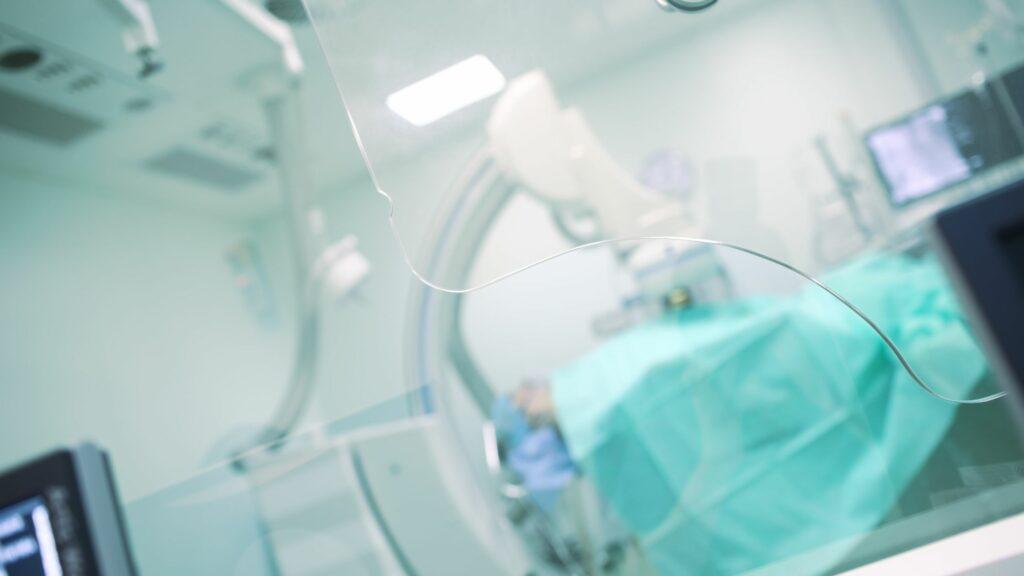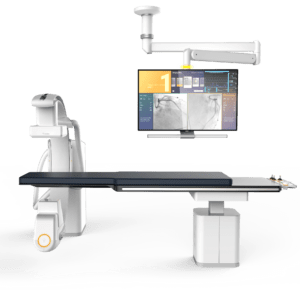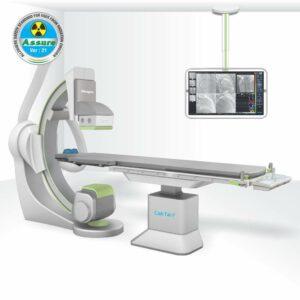Are you looking for a guide to Cath Labs? Look no further than this blog, packed with everything you need to know about equipment, procedures, and advancements in this critical medical field.
From essential equipment for seamless procedures to advanced imaging techniques revolutionizing diagnostic precision, we’ve got you covered. And, if you’re looking for a reliable B2B platform to promote Indian medical devices in emerging markets, check out Medzell, a futuristic platform that connects buyers and sellers across the globe.
So, let’s dive in and explore everything you need to know about Cath Labs, including the latest advancements and best practices for improved patient outcomes.
Welcome to our blog on Cath Labs, where we delve into the realm of advanced technology and innovations revolutionizing cardiovascular care. In this blog, we will explore essential equipment, high-quality supplies, cutting-edge devices, and reliable instruments used in Cath Labs.
Essential Cath Lab Equipment for Efficient Procedures
Some of the essential equipment includes angiography systems, electrocardiogram machines, catheters, guidewires, sheaths, and balloons. When it comes to performing procedures in the Cath Lab, having the right equipment is essential for ensuring seamless and effective interventions. From diagnostic tools to interventional devices, each piece of equipment plays a crucial role in delivering optimal patient care.
One of the primary diagnostic tools found in every Cath Lab is the cardiac catheterization system. This system allows healthcare professionals to visualize and assess the condition of the patient’s arteries and heart. Additionally, imaging equipment such as fluoroscopy machines and angiography systems provide real-time visualization during procedures, aiding in accurate diagnosis and treatment planning.
Interventional devices like guide wires, catheters, and balloons are indispensable for performing various procedures in the Cath Lab. Guide wires help navigate through the blood vessels, while catheters allow access to specific areas for interventions. Balloons, on the other hand, are used in angioplasty procedures to open up narrowed or blocked arteries. Additionally, precision instruments like stent delivery systems and intravascular ultrasound (IVUS) catheters are used for precise stent placement and imaging, respectively.
Types of Cath labs
Cath labs, short for cardiac catheterization laboratories, are specialized medical facilities where medical professionals use diagnostic imaging equipment and catheters to examine and treat various heart conditions. Here are some types of cath labs:
- Interventional Cath Lab: Interventional cath labs are used to perform minimally invasive procedures to treat heart conditions such as angioplasty, stenting, and other interventions that can improve blood flow to the heart.
- Electrophysiology (EP) Lab: This type of cath lab is used to diagnose and treat arrhythmias or irregular heartbeats. It uses specialized equipment and techniques to evaluate the electrical activity of the heart and correct any issues.
- Hybrid Cath Lab: Hybrid cath labs combine the capabilities of a surgical operating room with the diagnostic and interventional capabilities of a cath lab. These labs allow for more complex procedures, such as heart valve replacements or other surgeries that require imaging guidance.
- Peripheral Vascular Lab: This type of cath lab focuses on diagnosing and treating vascular diseases that affect the arteries and veins.
- Neurointerventional Lab: Neurointerventional cath labs specialize in treating conditions that affect the blood vessels in the brain, such as aneurysms or strokes. These labs use catheter-based techniques to deliver medication or other interventions directly to the affected area of the brain.
- Pediatric Cath Lab: Pediatric cath labs are specialized facilities that focus on diagnosing and treating heart conditions in children. These labs are equipped with specialized imaging equipment and catheters.
- Radiation Oncology Lab: Radiation oncology cath labs are specialized facilities that use catheter-based techniques to deliver radiation therapy directly to cancerous tumors. These labs allow for more precise delivery of radiation therapy and can minimize damage to healthy tissue.
- Hybrid Operating Room: A hybrid operating room is a type of cath lab that is equipped with both surgical and imaging equipment. This type of facility allows for complex surgical procedures to be performed using real-time imaging guidance.
- Overall, cath labs are versatile facilities that can be customized to meet the needs of different patient populations and medical specialties.
High-Quality Cath Lab Supplies for Accurate Diagnostics
From contrast agents to pressure transducers, high-quality supplies are critical for accurate diagnostics and effective treatments. So, make sure you invest in the right supplies to improve patient outcomes and streamline your procedures.
When it comes to accurate diagnostics in Cath Labs, high-quality supplies play a vital role. These supplies are essential for ensuring precise measurements, reliable results, and optimal patient care. By using premium Cath Lab supplies, healthcare professionals can enhance diagnostic accuracy and improve procedural efficiency.
A wide range of reliable Cath Lab supplies is available to meet the specific needs of diagnostic procedures. This includes catheters, guide wires, pressure transducers, sheaths, and more. Using high-quality Cath Lab supplies offers several benefits. Firstly, they provide accurate measurements, enabling healthcare professionals to make informed decisions regarding patient diagnosis and treatment. Secondly, these supplies are manufactured to meet stringent quality standards, ensuring their reliability and consistency.
By utilizing reliable and premium supplies, healthcare professionals can trust in the accuracy of their measurements and perform procedures with confidence. These supplies contribute to procedural efficiency, ensuring a smooth workflow and ultimately improving patient outcomes.
Cutting-Edge Cath Lab Devices for Precise Interventions
From stents and valves to imaging tools and robotic-assisted interventions, cutting-edge devices are transforming the Cath Lab landscape. Cutting-edge Cath Lab devices are transforming the landscape of interventional procedures by enabling precise interventions and enhancing patient outcomes.
By exploring these cutting-edge Cath Lab devices, healthcare professionals can stay updated with the latest advancements in the field. These devices encompass a wide range of instruments, including advanced catheters, imaging systems, navigation tools, and therapeutic devices. They are designed to provide improved visualization, better maneuverability, and enhanced treatment options.
The integration of advanced technologies in Cath Lab devices allows for more precise interventions, leading to better patient outcomes. These devices enable healthcare professionals to target specific areas with increased accuracy, minimizing the risk of complications and optimizing treatment effectiveness.
Staying informed about the latest advancements in Cath Lab devices is crucial for healthcare professionals to enhance their knowledge and skills. By incorporating cutting-edge devices into their practice, they can offer patients the benefits of improved treatment options and better outcomes.
Reliable Cath Lab Instruments for Procedural Success
From catheterization trays to hemostatic devices, reliable instruments are essential for procedural success. So, choose your instruments wisely and invest in high-quality devices to improve patient outcomes.
When it comes to Cath Lab procedures, precision is of utmost importance. Reliable instruments play a critical role in achieving accurate measurements, precise manipulations, and smooth workflow. They provide healthcare professionals with the confidence and assurance needed to perform procedures effectively.
Durability is another key aspect of reliable Cath Lab instruments. These instruments are built to withstand the rigors of interventional procedures, ensuring longevity and consistent performance. By using durable instruments, healthcare professionals can focus on the task at hand without the worry of instrument failure or malfunction.
Ease of use is also a crucial factor in the selection of Cath Lab instruments. Instruments that are intuitive to handle and operate streamline the procedural workflow and contribute to efficiency. They allow healthcare professionals to work more effectively, saving time and minimizing potential errors.
Exploring Stent Placement in Cath Lab
Stent placement is a common interventional procedure used to treat blocked or narrowed arteries. It involves inserting a small mesh tube called a stent to keep the artery open and improve blood flow. Stent placement is a crucial procedure performed in Cath Labs to restore blood flow in blocked or narrowed arteries. By exploring the process of stent placement, one can gain a comprehensive understanding of its significance in cardiovascular care.
During stent placement, a small mesh-like tube, known as a stent, is inserted into the affected artery to widen and reinforce it. It is essential to explore the different types of stents used in Cath Labs, including bare-metal stents, drug-eluting stents, and bioresorbable stents. Each type has its unique characteristics, benefits, and considerations, which influence the selection process.
Understanding the recovery process after stent placement is crucial for patients. By exploring these aspects, patients can be well-informed and actively participate in their recovery journey.
Future of Cath Labs: Robotic-Assisted Interventions
Robotic-assisted interventions are rapidly evolving, offering new possibilities for precise, minimally invasive procedures. From robotic catheterization systems to surgical robots, the future of Cath Labs looks promising.The future of Cath Labs is being shaped by the integration of robotic-assisted interventions. Robotic systems are revolutionizing the way procedures are performed, offering enhanced precision, control, and efficiency.
Robotic-assisted interventions in Cath Labs have the potential to bring numerous benefits. These include increased procedural accuracy, reduced radiation exposure for healthcare professionals, and improved patient outcomes. The robotic systems provide intricate maneuverability, allowing for precise movements during complex procedures.
Currently, robotic-assisted interventions are being utilized in various cardiac procedures, such as angioplasty and stent placement. However, the potential applications extend beyond these procedures. Robotic technology holds promise for advanced interventions like robotically-guided electrophysiology studies and complex structural heart procedures.
As technology continues to evolve, the future of robotic-assisted interventions in Cath Labs looks promising.
Revolutionizing Cardiac Care: Hybrid Cath Labs
Hybrid Cath Labs combine the advantages of surgical and interventional procedures, enabling comprehensive cardiac care in a single setting. They offer enhanced collaboration between different specialties and improved patient outcomes.
Hybrid Cath Labs have revolutionized cardiac care by combining the capabilities of both surgical and interventional procedures. The integration of different technologies and procedures in a single lab allows for a more efficient and effective approach to cardiac care. With hybrid Cath Labs, patients can benefit from faster recovery times, reduced hospital stays, and improved overall quality of care. As technology continues to advance, the future of hybrid procedures in Cath Labs is promising, offering even more advanced options for cardiac care.
Innovations in Cath Lab Imaging: Beyond Traditional Methods
Beyond traditional imaging methods, Cath Labs are embracing advanced technologies to improve diagnostic accuracy. From 3D imaging to virtual reality, these innovations are transforming the way we visualize and understand the heart. So, if you’re curious about the future of imaging in Cath Labs, keep reading.
In Cath Labs, advancements in imaging techniques are revolutionizing diagnostic precision and enhancing the understanding of complex cardiac conditions. Beyond traditional imaging methods, innovative technologies are opening new frontiers in visualizing the heart.
One such advancement is 3D imaging. This technology allows healthcare professionals to better assess anatomical details and plan interventions with greater accuracy.
Virtual reality (VR) is another cutting-edge tool being adopted in Cath Labs. By immersing physicians in a virtual environment, VR enables a realistic and interactive exploration of the heart. It offers a unique perspective, enhancing procedural planning and aiding in patient education.
Moreover, other emerging technologies like augmented reality, fusion imaging, and advanced software algorithms are further pushing the boundaries of Cath Lab imaging. These innovations provide enhanced visualization, precise navigation, and improved guidance during interventions.
By embracing these innovations, Cath Labs are unlocking new possibilities for diagnosis, treatment, and patient outcomes. The integration of advanced imaging techniques offers a comprehensive understanding of cardiac conditions and supports the delivery of personalized care.
Cath Labs from Leading Indian Manufacturers
Pinnacle
Pinnacle, is an exceptional cath lab manufactured by Innovation Imaging Technologies Pvt. Ltd. Pinnacle has gained recognition as one of the best cath labs available in the market.
Designed to meet international medical imaging standards, Pinnacle is proudly made in India and accessible worldwide. It incorporates groundbreaking supercomputing algorithms, revolutionizing medical imaging technology. These algorithms deliver sharp, virtually noise-free, and high-resolution images, setting a new standard in image quality.
Pinnacle prioritizes radiation safety for medical staff, patients, and clinical personnel. It achieves this by employing the latest imaging technology methods and utilizing the image processing chain to lower radiation exposure.
Equipped with high-quality, high-speed noise reduction algorithms, Pinnacle ensures enhanced image quality, high contrast, and image sharpness. This enables clinicians to observe even the minutest details during challenging cardiac and vascular operations, facilitating accurate diagnoses and interventions.
Pinnacle offers a comprehensive solution by providing all necessary clinical, technical, and image data on a single screen. It offers multiple layouts that can be tailored to the specific needs and procedural requirements of clinicians, ensuring a personalized and efficient workflow. Additionally, the device features a flexible window that can display important data such as hemodynamic, intravascular ultrasound (IVUS), and fractional flow reserve (FFR) measurements.
The physical controls and touch screen functionality of Pinnacle enable seamless control of patient data through a tablet interface. This dual-control mechanism enhances the usability and convenience of the device. Furthermore, Pinnacle boasts the smallest CO2 footprint among similar products, resulting in cost savings and easy installation. Its compact design eliminates the need for costly renovations, making it suitable for small treatment rooms without compromising functionality.
Altima
Altima by Allengers Medical Systems Ltd., is a cutting-edge cath lab that delivers superior performance, increased dependability, and ease of use for cardiac and vascular imaging. Altima is designed to meet the demanding requirements of cardiologists, providing a single solution for comprehensive imaging needs.
Altima features a robust 100 KW, dual inverter X-ray generator equipped with a liquid metal bearing 3 MHU X-ray tube. This advanced system ensures faster heat dissipation, making it suitable for complex and prolonged procedures. With a grid control unit, Altima offers precise control and stability during imaging sessions.
The device incorporates a Flat Panel Detector with multiple beam-hardening filters, enabling low-dose imaging without compromising image quality. This feature emphasizes patient safety while delivering accurate diagnostic results.
For enhanced flexibility, Altima features a 3-axis fixed table with longitudinal, transverse, and up-and-down travel capabilities. This adjustable table offers stability and adaptability during imaging procedures. The floating carbon fiber top enhances patient comfort, ensuring a positive experience throughout the examination.
Altima is equipped with STENT View software, enabling enhanced visualization of stents. This advanced software aids in accurate stent placement and assessment. The device also offers multiple user-defined pre-programmable positions and an AFD display for LAO/RAO/CRA/CAU/SID positioning, ensuring precise imaging in various orientations.
To prioritize radiation safety, Altima incorporates non-contact proximal sensor-based anti-collision technology and A.S.S.U.R.E protocols. These features enhance radiation safety for both medical staff and patients, providing peace of mind during imaging procedures.
Medzell: Empowering the Future of Medical Device Promotion
Discover Medzell, a futuristic B2B platform designed to promote Indian medical devices in emerging markets. Experience a seamless ecosystem connecting manufacturers, suppliers, and healthcare providers for mutual growth and advancements in medical technology.
Medzell provides a global marketplace where Indian medical device manufacturers can showcase their innovative products and reach a wider audience. With its user-friendly interface and comprehensive features, Medzell is revolutionizing the way medical devices are promoted and traded. So, if you’re interested in expanding your reach and connecting with potential buyers, check out Medzell.
In conclusion, Cath Labs play a pivotal role in the diagnosis and treatment of cardiovascular conditions. With advanced equipment, supplies, devices, and instruments, Cath Labs enable healthcare professionals to provide optimal care and improve patient outcomes. Stay informed about the latest advancements and techniques in Cath Labs, and embrace the future of cardiovascular care.




